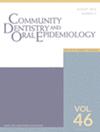Dental caries and school readiness in 5-year-olds: A birth cohort data linkage study
Abstract
Objective
To describe the association between dental caries and school readiness in 5-year-old children taking part in the Born in Bradford (BiB) birth cohort, UK.
Methods
The Early Years Foundation Stage Profile (EYFSP) assesses the school readiness of young children and is strongly predictive of future academic attainment. Children are recorded as ‘emerging’ (below expected), ‘expected’, or ‘exceeding’ in five key learning areas. The Oral Health Survey of 5-year-olds (OHS5) is undertaken biennially in England, assessing caries experience at a dentine threshold (d3mft). EYFSP and OHS5 were available for a proportion of children participating in BiB. Odds ratios and confidence intervals for caries experience were established, and odds ratios adjusted for significant sociodemographic variables.
Results
EYFSP and OHS5 data were available for 2.5% (n = 346) BiB participants. Nearly half (45.2%) had caries. A measure of socio-economic status, receiving free school meals, was the only demographic variable strongly related to caries experience (OR: 2.8, 95% CI: 1.6–4.9). After adjustment, children ‘emerging’ in EYFSP learning areas had 1.6- to 2.2-fold (95% CI: 1.0–3.8) higher odds of experiencing caries. Children ‘exceeding’ EYFSP learning areas had 2.3- to 4-fold (95% CI: 0.1–0.9) lower odds of caries experience.
Conclusion
This is the first study to explore the association between caries experience and school readiness using a holistic assessment tool. The association was found across different learning areas and was comparable to and independent of socio-economic status. The findings indicate oral health-related absenteeism is not a causative factor. EYFSP shows potential to enhance the targeting of preventive interventions at a child, class or school level.


 求助内容:
求助内容: 应助结果提醒方式:
应助结果提醒方式:


